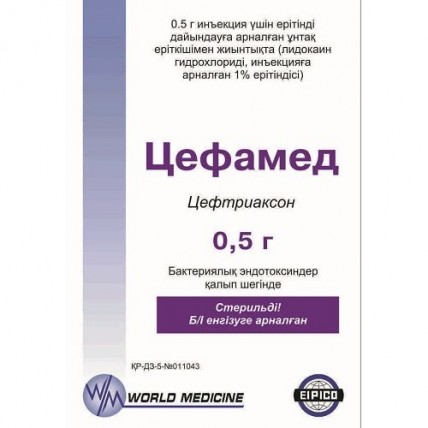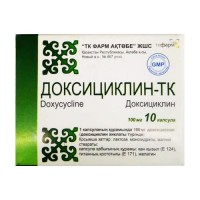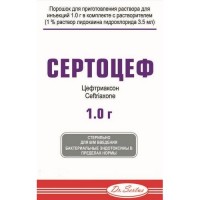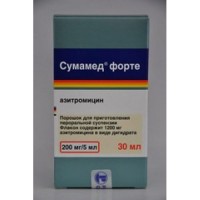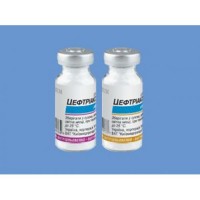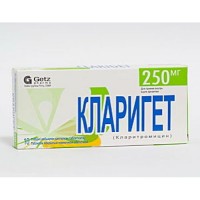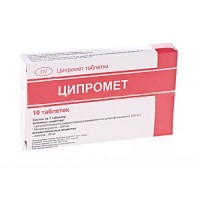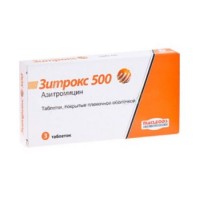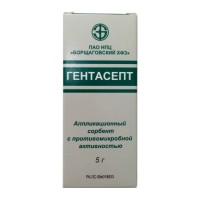Tsefamed 0.5 g, rast.2 ml of 1% solution of lidocaine 1's powder for solution for injection
- $10.40
The instruction for use
of Tsefamed Torgovoye medicine a name
Tsefamed
Mezhdunarodnoye the unlicensed
name Tseftriakson Lekarstvennaya a form
Powder for preparation of solution for injections, 0.5 g or 1.0 g complete with solvent (lidocaine of a hydrochloride, 1% solution for injections of 2.0 ml,
3.5 ml)
Structure
One bottle contains
active agent - tseftriakson (in the form of a tseftriakson of sodium) 500 mg or 1000 mg,
composition of solvent
1 ampoule of solvent contains
active substance-lidocaine a hydrochloride of 20 mg or 35 mg,
excipients: sodium hydroxide or acid chlorohydrogen,
water for injections
the Description
Crystal powder of white or yellowish color, is slightly hygroscopic.
Solvent: colourless, transparent liquid.
Pharmacotherapeutic group
Antibacterial drugs for system use. A beta – laktamny antibacterial drugs other. Cephalosporins of the third generation. Tseftriakson.
The ATX J01DD04 code
the Pharmacological
Pharmacokinetics At properties intramuscular/intravenous administration tseftriakson well gets into fabrics and liquids of an organism. The bioavailability at intramuscular introduction is 100%. The maximum concentration in blood plasma at intramuscular introduction is reached in 2-3 hours. Reversibly contacts blood plasma albumine for 85-95% and this binding in inverse proportion to its concentration in blood. Tseftriakson quickly diffuses in interstitial liquid where the bactericidal action concerning microorganisms, sensitive to it, keeps within 24 hours. Tseftriakson well gets through a blood-brain barrier.
Elimination half-life at adults makes about 8 hours, at elderly people 75 years are more senior it is extended approximately by 2-3 times, and at newborns makes 2-3 times more, than at adults of young age. At adult 50-60% of a tseftriakson 40-50% with bile are removed in not changed form with urine. At newborns about 70% of the entered dose of a tseftriakson it is removed by kidneys. In renal failures or a liver at adults the pharmacokinetics of a tseftriakson almost does not change (perhaps, insignificant lengthening of elimination half-life) thanks to redistribution of functions: if function of kidneys is broken, discharge with bile increases and if liver pathology takes place, then removal by kidneys amplifies.
The pharmacodynamics
Tsefamed represents an antibiotic of a broad spectrum of activity of a tsefalosporinovy number of the third generation. Has bactericidal effect due to oppression of synthesis of a cellular membrane of bacteria. It is active concerning the majority of gram-negative, many gram-positive activators and some anaerobe bacterias. It is resistant to action beta laktamaz, produced by bacteria.
Aerobic gram-negative bacteria, sensitive to Tsefamed: Aeromonas spp., Alcaligenes spp., Branhamella catarrhalis, Citrobacter spp., Enterobacter spp. (some strains are steady), E.coli, Haemophilus ducreyi, Haemophilus influenzae, Haemophilus parainfluenzae, Klebsiella spp. (including, Kl. pneumoniae), Moraxella spp., Morganella morganii, Neisseria gonorrhoeae, Neisseria meningitidis, Plesiomonas shigelloides, Proteus mirabilis, Proteus vulgaris, Providencia spp., Pseudomonas aeruginosa (some strains are steady), Salmonella spp. (including, S. typhi), Serratia spp. (including, S. marcescens), Shigella spp., Vibrio spp. (including, V. cholerae), Yersinia spp. (including, Y. enterocolitica).
Many strains of above-mentioned microorganisms which in the presence of other antibiotics, for example, of penicillin, cephalosporins of the first and second generations and aminoglycosides steadily breed are sensitive to Tsefamed. According to clinical data in primary and secondary syphilis are noted good efficiency of drug.
Aerobic gram-positive bacteria sensitive to Tsefamed: Streptococcus agalactiae, Staphylococcus aureus (including the strains producing penicillinase), Streptococcus bovis, Staphylococcus epidermidis, Streptococcus pneumoniae, Streptococcus pyogenes, Streptococcus viridans.
Staphylococcus spp. resistant to Methicillinum, rezistenten and to cephalosporins, including to Tsefamed. Majority of strains of Enterococcus spp. (for example, Streptococcus faecalis) are also resistant to drug.
Anaerobic activators: Bacteroides spp. (including, some strains of V. of fragilis), Clostridium spp. (including, Cl. difficile), Fusobacterium spp. (except F. mortiferum and F. varium), Peptococcus spp., Peptostreptococcus spp. Some strains of Bacteroides spp. (for example, V. of fragilis), the developing beta lactamazu, are resistant to Tsefamed.
Indications
Tsefamed is effective in the diseases caused by strains of bacteria, sensitive to it:
- diseases of upper and lower airways (including, pneumonia, abscess of lungs, a pleura empyema)
- infections of abdominal organs (including, a cholangitis, an empyema of a gall bladder)
- inflammatory diseases of digestive tract, biliary tract, peritonitis
- infections of bones and joints
- infections of skin and soft tissues
- infections of urinary tract (including, pyelonephritis)
- infections, sexually transmitted (including, gonorrhea)
- contaminated wounds and burns
- inflammation of meningeal covers, sepsis
- for prevention of postoperative infectious complications.
The route of administration and doses
Tsefamed enter intramusculary and intravenously struyno or by drop infusion.
Usual doses for adults and children at the age of 12 years are also more senior make
1-2 g of Tsefamed once a day. An interval between introductions – 24 hours. In hard cases or in the infections caused by moderately sensitive bacteria, the daily dose of drug can be increased up to 4 g.
The newborn (to two-week age) Tsefamed appoint in a dose
20-50 mg/kg of body weight once a day. Exceeding a dose is inadmissible because of immaturity of a fermental system at newborns.
Tseftriakson is contraindicated to newborns (≤8 days) who already appoints or supposes intravenous treatment kaltsiysoderzhashchy solutions, including long kaliysoderzhashchy infusions because of formation of precipitated calcium superphosphates of calcic salts.
For babies and children aged up to 12 years the daily dose of Tsefamed makes 20-80 mg/kg of body weight once a day. Children with body weight have over 50 kg and more apply usual doses to adults.
Intravenous administration of drug in a dose more than 50 mg/kg of body weight has to be carried out by drop infusion within not less than 30 minutes.
Duration of treatment depends on character and disease severity. Tsefamed's introduction is recommended to continue not less than within 3 days after normalization of body temperature.
In bacterial meningitis to newborns and children drug appoint in an initial dose 100 mg/kg of body weight once a day. The maximum daily dose – 4 g. After identification of the activator, the dose can be reduced.
At treatment of a gonococcal infection (without complications) the recommended dose makes 250 mg of Tsefamed once intramusculary.
At treatment of gonorrhea (treatment of patients should be performed in stationary conditions). Tactics of therapy depends on the nature of a clinical course of gonorrhea. So, when abscessing paraurethral and big vestibular glands along with the antimicrobial drugs effective concerning N. gonorrhoeae, it is necessary to use the corresponding pathogenetic, physiotherapeutic and surgical methods of treatment. Etiological treatment of the complicated gonococcal infection of an urinary system and bodies of a small pelvis: Tsefamed of-1.0 g intramusculary each 24 hours.
Patients with renal failures on condition of normal function of a liver and at patients with abnormal liver functions on condition of the kept function of kidneys have no need for reduction of a dose of drug. In case of the profound renal failure (clearance of creatinine less than 10 ml/min.) Tsefameda should not exceed 2 g a day.
In a simultaneous abnormal liver function and kidneys and also at the patients who are on a hemodialysis it is regularly necessary to control concentration of a tseftriakson in blood serum. For prevention of postoperative infections the single introduction of 1-2 g of Tsefamed in 30-90 minutes prior to operation is recommended.
Rules of preparation and administration of drug
For intramuscular introduction of 500 mg or 1 g of powder dissolve in 2 or 3.5 ml 1% of solution of lidocaine respectively and enter deeply into a gluteus. Lidocaine is not used as solvent in pediatric practice.
For intravenous administration the contents of one bottle of Tsefamed of 500 mg or 1 g are parted in 5 or 10 ml of the sterile distilled water respectively and entered into a vein slowly within 2-4 minutes.
For intravenous infusion of 2 g of drug dissolve in 40 ml 0.9% of solution of sodium of chloride, 5% of solution of glucose, 10% of solution of glucose, 5% of solution of fructose, 6% of solution of a dextran. Duration of intravenous infusion has to be not less than 30 minutes.
Solution of drug has to be used at once after its preparation!
Side effects
Are possible:
a dieback, allergic dermatitis, swell, an itching, urticaria, an acute anaphylaxis, a multiformny erythema
- diarrhea, nausea, vomiting, stomatitis, a glossitis
- an eosinophilia, a leukopenia, a granulocytopenia, hemolytic anemia, an agranulocytosis, thrombocytopenia
- fever, a fever
Seldom:
- a headache, dizziness,
- increase in activity of hepatic transaminases, an oliguria, increase in content of creatinine in blood serum
In isolated cases:
- a multiformny erythema, Stephens's syndrome – Johnson, a toxic epidermal syndrome (Lyell's disease)
- pseudomembranous colitis
- fibrillation disturbance, at intravenous administration morbidity on the vein course, phlebitis
- arrhythmias (at fast introduction)
- bleedings
- dysbacteriosis, candidiasis
- precipitation of calcic salts of a tseftriakson in a gall bladder.
Contraindications
- hypersensitivity to cephalosporins and penicillin
- hypersensitivity to solvent - lidocaine (solvent can be replaced with novocaine or water for injections)
- the first trimester of pregnancy
- a hyperbilirubinemia at newborn and premature children
- a renal/liver failure
- the nonspecific ulcer colitis, enteritis or colitis connected with use of antibacterial drugs
- existence in the anamnesis of bleedings
- newborns (≤28 days) which already appoints or supposes intravenous treatment kaltsiysoderzhashchy solutions including long kaltsiysoderzhashchy infusions, for example, at parenteral nutrition, because of risk of formation of precipitated calcium superphosphates of calcic salts of a tseftriakson
Medicinal interactions
At simultaneous use with loopback diuretics (for example, furosemide) renal failures are not observed. Tsefamed and aminoglycosides have synergism concerning many gram-negative bacteria. The similar combination is proved at treatment heavy and life-threatening infections (for example, caused by such activator as Pseudomonas aeroginosa).
It is not necessary to mix Tsefamed rolled into one or the syringe with other antibiotics.
Bacteriostatic antibiotics reduce bactericidal effect of a tseftriakson.
In vitro was found antagonism between chloramphenicol and tseftriaksony.
Tseftriakson pharmaceutical is incompatible with amsakriny, Vancomycinum, flukonazoly and aminoglycosides.
Special instructions
At the Tsefamed drug treatment it is necessary to consider a possibility of development of anaphylactic reactions, with care to appoint in the presence in the anamnesis of allergic reactions to penicillin. At long-term treatment by drug regular control of a picture of peripheral blood is necessary.
After use of a tseftriakson, usually in the doses exceeding standard recommended, at ultrasound examination of a gall bladder, shadows which mistakenly took for stones came to light. They represent precipitated calcium superphosphates of calcic salt of a tseftriakson which disappear after end or the termination of therapy tseftriaksony. Similar changes seldom give any symptomatology, but also in such cases only the conservative treatment is recommended. If these phenomena are followed by clinical symptomatology, then the decision on drug withdrawal is left to the discretion of the attending physician. Pancreatitis possible cases.
Interaction with calcium ions
separate fatal cases of formation of precipitated calcium superphosphates in lungs and kidneys by results of an autopsy research at the newborns receiving tseftriakson and kaltsiysoderzhashchy solutions Are described. At the same time one venous access was in some cases used, and formation of precipitated calcium superphosphates was observed directly in a system for intravenous administration. At least, one case from the death is also described, at various venous accesses and to various time of introduction of a tseftriakson and calcium - the containing solutions. At the same time by results of an autopsy research precipitated calcium superphosphates were not found in this newborn. Similar cases were observed only at newborns.
It was reported about sporadic cases of an agranulocytosis (& lt, 500/ml), the most part from them was observed after 10 days of treatment and against the background of purpose of total doses more than 20 g.
It was reported about sporadic cases of serious reactions (multiformny erythema, Stephens-Johnson's syndrome, a toxic epideramlny necrolysis (Lyell's disease)).
Very exceptional cases of pseudomembranous colitis are described (& lt, 0.01%) and in kidneys, mainly, at children 3 years which were receiving or high daily doses of drug (more than 80 mg/kg a day), or cumulative doses more than 10 g and also having accessory factors of risk (liquid consumption restriction, a bed rest, etc.) are more senior than disturbances of blood clotting and also formation of concrements. Formation of concrements in kidneys can proceed asymptomatically or clinically be shown, can lead to a renal failure.
Drug it is necessary to appoint use in pediatrics with care the newborn, in particular premature, in connection with high risk of development of a hyperbilirubinemia.
Pregnancy and the period a lactation
Safety of use at pregnancy is not established.
Use of the drug Tsefamed during pregnancy is possible only when the expected advantage for mother exceeds potential risk for a fruit (tseftriakson gets through a placental barrier).
In need of use of the drug Tsefamed in the period of a lactation it is necessary to resolve an issue of the breastfeeding termination (tseftriakson it is allocated with breast milk).
Features of influence of medicine on ability to run the vehicle or potentially dangerous mechanisms
Considering side effects of drug it is necessary to be careful at control of motor transport and work with mechanisms.
Overdose
Symptoms: strengthening of side effects
Treatment: symptomatic. The hemodialysis and peritoneal dialysis are not effective, there is no specific antidote.
A form of release and packing
On 0.5 g and 1.0 g of drug in the bottle from glass corked by a rubber bung and the pressed-out cap aluminum the flip-off type.
On 2.0 ml and 3.5 ml of solvent pack into ampoules from glass.
On 1 bottle and 1 ampoule with solvent put in blister strip packaging.
On 1 planimetric packing together with the instruction for medical use in the state and Russian languages place in a box of cardboard.
To Store storage conditions at a temperature not above 25 °C.
To store out of children's reach!
A period of storage
3 years
not to apply after an expiration date
Prescription status
According to the prescription
Producer/packer E.I.P.I. To., Egypt,
Tens ov City Ramadan,
the First B1 Industrial Zone, p.o. box 149 Tens
("E.I.P.I.CO." Egypt, Tenth of Ramadan City, First Industrial Area B1, P.O. box: 149 Tenth)
the Owner of the registration certificate "UORLD MEDITSIN", Great Britain ("WORLD MEDICINE", Great Britain)
btel / fax: 8 (7272) 529090www.worldmedicine.kz
to Develop the Address of the organization accepting in the territory of the Republic of Kazakhstan claims from consumers on quality produktsiirk Almaty, Turksibsky district, Suyunbaya Ave., 222
of Tsefamed Torgovoye medicine a name
Tsefamed
Mezhdunarodnoye the unlicensed
name Tseftriakson Lekarstvennaya a form
Powder for preparation of solution for injections, 0.5 g or 1.0 g complete with solvent (lidocaine of a hydrochloride, 1% solution for injections of 2.0 ml,
3.5 ml)
Structure
One bottle contains
active agent - tseftriakson (in the form of a tseftriakson of sodium) 500 mg or 1000 mg,
composition of solvent
1 ampoule of solvent contains
active substance-lidocaine a hydrochloride of 20 mg or 35 mg,
excipients: sodium hydroxide or acid chlorohydrogen,
water for injections
the Description
Crystal powder of white or yellowish color, is slightly hygroscopic.
Solvent: colourless, transparent liquid.
Pharmacotherapeutic group
Antibacterial drugs for system use. A beta – laktamny antibacterial drugs other. Cephalosporins of the third generation. Tseftriakson.
The ATX J01DD04 code
the Pharmacological
Pharmacokinetics At properties intramuscular/intravenous administration tseftriakson well gets into fabrics and liquids of an organism. The bioavailability at intramuscular introduction is 100%. The maximum concentration in blood plasma at intramuscular introduction is reached in 2-3 hours. Reversibly contacts blood plasma albumine for 85-95% and this binding in inverse proportion to its concentration in blood. Tseftriakson quickly diffuses in interstitial liquid where the bactericidal action concerning microorganisms, sensitive to it, keeps within 24 hours. Tseftriakson well gets through a blood-brain barrier.
Elimination half-life at adults makes about 8 hours, at elderly people 75 years are more senior it is extended approximately by 2-3 times, and at newborns makes 2-3 times more, than at adults of young age. At adult 50-60% of a tseftriakson 40-50% with bile are removed in not changed form with urine. At newborns about 70% of the entered dose of a tseftriakson it is removed by kidneys. In renal failures or a liver at adults the pharmacokinetics of a tseftriakson almost does not change (perhaps, insignificant lengthening of elimination half-life) thanks to redistribution of functions: if function of kidneys is broken, discharge with bile increases and if liver pathology takes place, then removal by kidneys amplifies.
The pharmacodynamics
Tsefamed represents an antibiotic of a broad spectrum of activity of a tsefalosporinovy number of the third generation. Has bactericidal effect due to oppression of synthesis of a cellular membrane of bacteria. It is active concerning the majority of gram-negative, many gram-positive activators and some anaerobe bacterias. It is resistant to action beta laktamaz, produced by bacteria.
Aerobic gram-negative bacteria, sensitive to Tsefamed: Aeromonas spp., Alcaligenes spp., Branhamella catarrhalis, Citrobacter spp., Enterobacter spp. (some strains are steady), E.coli, Haemophilus ducreyi, Haemophilus influenzae, Haemophilus parainfluenzae, Klebsiella spp. (including, Kl. pneumoniae), Moraxella spp., Morganella morganii, Neisseria gonorrhoeae, Neisseria meningitidis, Plesiomonas shigelloides, Proteus mirabilis, Proteus vulgaris, Providencia spp., Pseudomonas aeruginosa (some strains are steady), Salmonella spp. (including, S. typhi), Serratia spp. (including, S. marcescens), Shigella spp., Vibrio spp. (including, V. cholerae), Yersinia spp. (including, Y. enterocolitica).
Many strains of above-mentioned microorganisms which in the presence of other antibiotics, for example, of penicillin, cephalosporins of the first and second generations and aminoglycosides steadily breed are sensitive to Tsefamed. According to clinical data in primary and secondary syphilis are noted good efficiency of drug.
Aerobic gram-positive bacteria sensitive to Tsefamed: Streptococcus agalactiae, Staphylococcus aureus (including the strains producing penicillinase), Streptococcus bovis, Staphylococcus epidermidis, Streptococcus pneumoniae, Streptococcus pyogenes, Streptococcus viridans.
Staphylococcus spp. resistant to Methicillinum, rezistenten and to cephalosporins, including to Tsefamed. Majority of strains of Enterococcus spp. (for example, Streptococcus faecalis) are also resistant to drug.
Anaerobic activators: Bacteroides spp. (including, some strains of V. of fragilis), Clostridium spp. (including, Cl. difficile), Fusobacterium spp. (except F. mortiferum and F. varium), Peptococcus spp., Peptostreptococcus spp. Some strains of Bacteroides spp. (for example, V. of fragilis), the developing beta lactamazu, are resistant to Tsefamed.
Indications
Tsefamed is effective in the diseases caused by strains of bacteria, sensitive to it:
- diseases of upper and lower airways (including, pneumonia, abscess of lungs, a pleura empyema)
- infections of abdominal organs (including, a cholangitis, an empyema of a gall bladder)
- inflammatory diseases of digestive tract, biliary tract, peritonitis
- infections of bones and joints
- infections of skin and soft tissues
- infections of urinary tract (including, pyelonephritis)
- infections, sexually transmitted (including, gonorrhea)
- contaminated wounds and burns
- inflammation of meningeal covers, sepsis
- for prevention of postoperative infectious complications.
The route of administration and doses
Tsefamed enter intramusculary and intravenously struyno or by drop infusion.
Usual doses for adults and children at the age of 12 years are also more senior make
1-2 g of Tsefamed once a day. An interval between introductions – 24 hours. In hard cases or in the infections caused by moderately sensitive bacteria, the daily dose of drug can be increased up to 4 g.
The newborn (to two-week age) Tsefamed appoint in a dose
20-50 mg/kg of body weight once a day. Exceeding a dose is inadmissible because of immaturity of a fermental system at newborns.
Tseftriakson is contraindicated to newborns (≤8 days) who already appoints or supposes intravenous treatment kaltsiysoderzhashchy solutions, including long kaliysoderzhashchy infusions because of formation of precipitated calcium superphosphates of calcic salts.
For babies and children aged up to 12 years the daily dose of Tsefamed makes 20-80 mg/kg of body weight once a day. Children with body weight have over 50 kg and more apply usual doses to adults.
Intravenous administration of drug in a dose more than 50 mg/kg of body weight has to be carried out by drop infusion within not less than 30 minutes.
Duration of treatment depends on character and disease severity. Tsefamed's introduction is recommended to continue not less than within 3 days after normalization of body temperature.
In bacterial meningitis to newborns and children drug appoint in an initial dose 100 mg/kg of body weight once a day. The maximum daily dose – 4 g. After identification of the activator, the dose can be reduced.
At treatment of a gonococcal infection (without complications) the recommended dose makes 250 mg of Tsefamed once intramusculary.
At treatment of gonorrhea (treatment of patients should be performed in stationary conditions). Tactics of therapy depends on the nature of a clinical course of gonorrhea. So, when abscessing paraurethral and big vestibular glands along with the antimicrobial drugs effective concerning N. gonorrhoeae, it is necessary to use the corresponding pathogenetic, physiotherapeutic and surgical methods of treatment. Etiological treatment of the complicated gonococcal infection of an urinary system and bodies of a small pelvis: Tsefamed of-1.0 g intramusculary each 24 hours.
Patients with renal failures on condition of normal function of a liver and at patients with abnormal liver functions on condition of the kept function of kidneys have no need for reduction of a dose of drug. In case of the profound renal failure (clearance of creatinine less than 10 ml/min.) Tsefameda should not exceed 2 g a day.
In a simultaneous abnormal liver function and kidneys and also at the patients who are on a hemodialysis it is regularly necessary to control concentration of a tseftriakson in blood serum. For prevention of postoperative infections the single introduction of 1-2 g of Tsefamed in 30-90 minutes prior to operation is recommended.
Rules of preparation and administration of drug
For intramuscular introduction of 500 mg or 1 g of powder dissolve in 2 or 3.5 ml 1% of solution of lidocaine respectively and enter deeply into a gluteus. Lidocaine is not used as solvent in pediatric practice.
For intravenous administration the contents of one bottle of Tsefamed of 500 mg or 1 g are parted in 5 or 10 ml of the sterile distilled water respectively and entered into a vein slowly within 2-4 minutes.
For intravenous infusion of 2 g of drug dissolve in 40 ml 0.9% of solution of sodium of chloride, 5% of solution of glucose, 10% of solution of glucose, 5% of solution of fructose, 6% of solution of a dextran. Duration of intravenous infusion has to be not less than 30 minutes.
Solution of drug has to be used at once after its preparation!
Side effects
Are possible:
a dieback, allergic dermatitis, swell, an itching, urticaria, an acute anaphylaxis, a multiformny erythema
- diarrhea, nausea, vomiting, stomatitis, a glossitis
- an eosinophilia, a leukopenia, a granulocytopenia, hemolytic anemia, an agranulocytosis, thrombocytopenia
- fever, a fever
Seldom:
- a headache, dizziness,
- increase in activity of hepatic transaminases, an oliguria, increase in content of creatinine in blood serum
In isolated cases:
- a multiformny erythema, Stephens's syndrome – Johnson, a toxic epidermal syndrome (Lyell's disease)
- pseudomembranous colitis
- fibrillation disturbance, at intravenous administration morbidity on the vein course, phlebitis
- arrhythmias (at fast introduction)
- bleedings
- dysbacteriosis, candidiasis
- precipitation of calcic salts of a tseftriakson in a gall bladder.
Contraindications
- hypersensitivity to cephalosporins and penicillin
- hypersensitivity to solvent - lidocaine (solvent can be replaced with novocaine or water for injections)
- the first trimester of pregnancy
- a hyperbilirubinemia at newborn and premature children
- a renal/liver failure
- the nonspecific ulcer colitis, enteritis or colitis connected with use of antibacterial drugs
- existence in the anamnesis of bleedings
- newborns (≤28 days) which already appoints or supposes intravenous treatment kaltsiysoderzhashchy solutions including long kaltsiysoderzhashchy infusions, for example, at parenteral nutrition, because of risk of formation of precipitated calcium superphosphates of calcic salts of a tseftriakson
Medicinal interactions
At simultaneous use with loopback diuretics (for example, furosemide) renal failures are not observed. Tsefamed and aminoglycosides have synergism concerning many gram-negative bacteria. The similar combination is proved at treatment heavy and life-threatening infections (for example, caused by such activator as Pseudomonas aeroginosa).
It is not necessary to mix Tsefamed rolled into one or the syringe with other antibiotics.
Bacteriostatic antibiotics reduce bactericidal effect of a tseftriakson.
In vitro was found antagonism between chloramphenicol and tseftriaksony.
Tseftriakson pharmaceutical is incompatible with amsakriny, Vancomycinum, flukonazoly and aminoglycosides.
Special instructions
At the Tsefamed drug treatment it is necessary to consider a possibility of development of anaphylactic reactions, with care to appoint in the presence in the anamnesis of allergic reactions to penicillin. At long-term treatment by drug regular control of a picture of peripheral blood is necessary.
After use of a tseftriakson, usually in the doses exceeding standard recommended, at ultrasound examination of a gall bladder, shadows which mistakenly took for stones came to light. They represent precipitated calcium superphosphates of calcic salt of a tseftriakson which disappear after end or the termination of therapy tseftriaksony. Similar changes seldom give any symptomatology, but also in such cases only the conservative treatment is recommended. If these phenomena are followed by clinical symptomatology, then the decision on drug withdrawal is left to the discretion of the attending physician. Pancreatitis possible cases.
Interaction with calcium ions
separate fatal cases of formation of precipitated calcium superphosphates in lungs and kidneys by results of an autopsy research at the newborns receiving tseftriakson and kaltsiysoderzhashchy solutions Are described. At the same time one venous access was in some cases used, and formation of precipitated calcium superphosphates was observed directly in a system for intravenous administration. At least, one case from the death is also described, at various venous accesses and to various time of introduction of a tseftriakson and calcium - the containing solutions. At the same time by results of an autopsy research precipitated calcium superphosphates were not found in this newborn. Similar cases were observed only at newborns.
It was reported about sporadic cases of an agranulocytosis (& lt, 500/ml), the most part from them was observed after 10 days of treatment and against the background of purpose of total doses more than 20 g.
It was reported about sporadic cases of serious reactions (multiformny erythema, Stephens-Johnson's syndrome, a toxic epideramlny necrolysis (Lyell's disease)).
Very exceptional cases of pseudomembranous colitis are described (& lt, 0.01%) and in kidneys, mainly, at children 3 years which were receiving or high daily doses of drug (more than 80 mg/kg a day), or cumulative doses more than 10 g and also having accessory factors of risk (liquid consumption restriction, a bed rest, etc.) are more senior than disturbances of blood clotting and also formation of concrements. Formation of concrements in kidneys can proceed asymptomatically or clinically be shown, can lead to a renal failure.
Drug it is necessary to appoint use in pediatrics with care the newborn, in particular premature, in connection with high risk of development of a hyperbilirubinemia.
Pregnancy and the period a lactation
Safety of use at pregnancy is not established.
Use of the drug Tsefamed during pregnancy is possible only when the expected advantage for mother exceeds potential risk for a fruit (tseftriakson gets through a placental barrier).
In need of use of the drug Tsefamed in the period of a lactation it is necessary to resolve an issue of the breastfeeding termination (tseftriakson it is allocated with breast milk).
Features of influence of medicine on ability to run the vehicle or potentially dangerous mechanisms
Considering side effects of drug it is necessary to be careful at control of motor transport and work with mechanisms.
Overdose
Symptoms: strengthening of side effects
Treatment: symptomatic. The hemodialysis and peritoneal dialysis are not effective, there is no specific antidote.
A form of release and packing
On 0.5 g and 1.0 g of drug in the bottle from glass corked by a rubber bung and the pressed-out cap aluminum the flip-off type.
On 2.0 ml and 3.5 ml of solvent pack into ampoules from glass.
On 1 bottle and 1 ampoule with solvent put in blister strip packaging.
On 1 planimetric packing together with the instruction for medical use in the state and Russian languages place in a box of cardboard.
To Store storage conditions at a temperature not above 25 °C.
To store out of children's reach!
A period of storage
3 years
not to apply after an expiration date
Prescription status
According to the prescription
Producer/packer E.I.P.I. To., Egypt,
Tens ov City Ramadan,
the First B1 Industrial Zone, p.o. box 149 Tens
("E.I.P.I.CO." Egypt, Tenth of Ramadan City, First Industrial Area B1, P.O. box: 149 Tenth)
the Owner of the registration certificate "UORLD MEDITSIN", Great Britain ("WORLD MEDICINE", Great Britain)
btel / fax: 8 (7272) 529090www.worldmedicine.kz
to Develop the Address of the organization accepting in the territory of the Republic of Kazakhstan claims from consumers on quality produktsiirk Almaty, Turksibsky district, Suyunbaya Ave., 222
